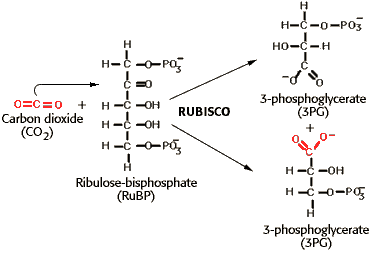Daily Newsletter March 7, 2012
Today's Topic: Carbon Fixation
One of the most important reactions in biology is the carbon fixation step of the Calvin Cycle. As discussed in lecture, there are other forms of carbon fixation found in bacteria, but when it comes to the global supply of bioavailable carbon, this the the main player.
What is the global supply of bioavailable carbon? Consider what you ate today? Did it consist of starches, vegetables, animals? Did it have protein, carbohydrates, lipids? These are all biomolecules derived from this initial reaction. You may have heard that all of our energy comes from the sun; well it is this reaction that converts solar energy into biological compounds.
Above is a great diagram of the carbon fixation step in the Calvin Cycle. CO2 is added to the second carbon. Remember, there is an unstable intermediate that is formed, which spontaneously splits into 3PG.
Ribulose 1,5 Bisphosphate Carboxylase (RuBisCo) is the enzyme that catalyzes the carbon fixation step. This enzyme is often cited as the most abundant enzyme on the plant, which is most like the case. No one though could doubt that it is the single most important enzyme, for without this, we would not have the quantity of organic carbon that is needed to support life as we know it.
Daily Challenge: The Calvin Cycle
Discuss the stages of the Calvin Cycle: Carbon Fixation, Redution of 3GP, and Regeneration of Ribulose 1,5 Bisphosphate. Include in your discussion of the reduction of 3GP how 2 G3P is converted to glucose.
In class I discussed the complexity of the regeneration step. The image below shows the route to the regeneration of Ribulose 1,5 Bisphosphate. The top of the picture deals with carbon fixation and reduction of 2GP. the rest shows the regeneration steps.
For your blog, if you would like, go through the steps and see if you can explain what is happening. What is required is that you show an understanding of the major stages of the Calvin cycle; going through the individual steps though could aid your understanding.
Learning Objectives: It should be obvious from class and this newsletter that learning and understanding the carbon fixation step is critical. What of the rest of the Calvin Cycle? Do you need to memorize the rest of the cycle?

No comments:
Post a Comment